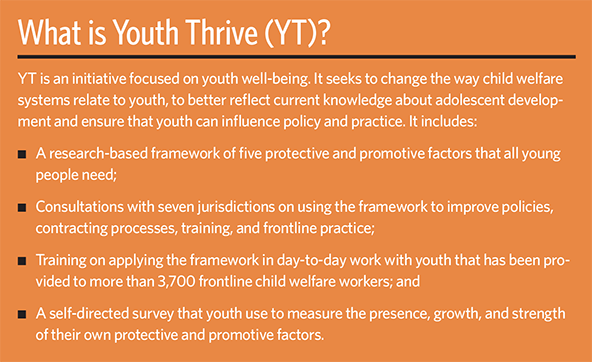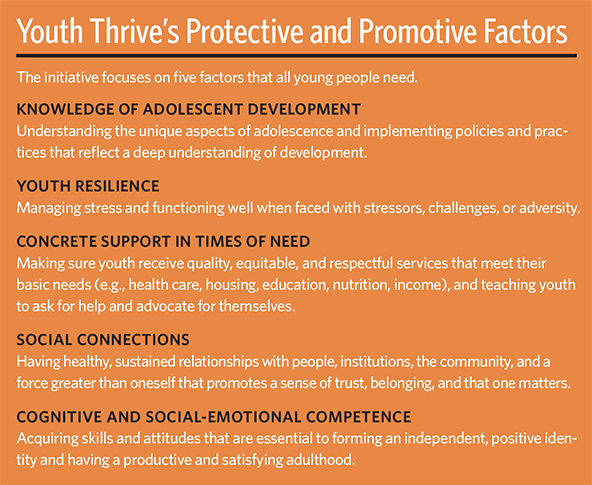 (Photo by iStock/SDI Productions)
(Photo by iStock/SDI Productions)
“Nothing about us, without us,” is a rallying cry that originated in the disability rights movement, but it has been widely adopted by young people who have been in foster care. The stakes are high. “One person frames your life before a court, and a couple of people decide where you live,” says Sixto Cancel about his experience with the system. Cancel remembers just how little say he had in his own future and how that made him feel. “Your life goes on a whole [unwanted] trajectory because someone didn’t ask you [what you needed],” Cancel says.
Bringing Equity to Implementation

Implementation science—the study of the uptake, scale, and sustainability of social programs—has failed to advance strategies to address equity. This collection of articles reviews case studies and articulates lessons for incorporating the knowledge and leadership of marginalized communities into the policies and practices intended to serve them. Sponsored by the Anne E. Casey Foundation
-
Equity Is Fundamental to Implementation Science
-
Trust the People
-
Youth Leadership in Action
-
Community Takes the Wheel
-
Equity in Implementation Science Is Long Overdue
-
Listening to Black Parents
-
Faith-Based Organizations as Leaders of Implementation
-
Community-Defined Evidence as a Framework for Equitable Implementation
-
Community-Driven Health Solutions on Chicago’s South Side
-
Equitable Implementation at Work
Ensuring that young people have a say in their futures—not just as individuals, but collectively regarding decisions about child welfare policy and practice—is a goal of Youth Thrive (YT), an initiative of the Center for the Study of Social Policy (CSSP) focused on youth well-being. CSSP staff wanted to create a bold initiative to address long-entrenched practices in child welfare systems around the country. To do so, CSSP knew it would have to draw on not only current research about adolescent development and systems change, but also the experiences and expertise of young people themselves. Cancel was one among many young people with experience in foster care who helped develop and implement the effort.
How might youth and young adults with experience in foster care play an integral role in an initiative like this? The challenges are considerable. Typically, adults have power and young people do not. Adults in human-services organizations have experience deliberating changes in policies and practices, while young people usually do not. Meetings are commonly held during hours when young people are likely to be in school or at a job, making it difficult for them to participate. Staff members are paid for their time, while youth generally are not. Perhaps most significantly, adults often dismiss the value of listening to young people about what they want and need. Given these constraints, how can organizations ensure that the participation of youth and young adults is more than tokenism?
Laying a Foundation
When CSSP Executive Vice President Susan Notkin began to conceptualize Youth Thrive, she was influenced by her previous work with parents whose children had been taken away and placed in foster care. “[The parents] taught me things about what they needed that I hadn’t imagined,” Notkin says. Notkin brought this mindset to bear on her work with YT. Along with a review and analysis of relevant YT research, Notkin engaged 30 youth who had been in foster care to talk about what had helped them during their time in foster care and what they would have wanted to change.

In launching Youth Thrive, CSSP partnered with youth to carry out two important activities. First, young people with foster care experience co-facilitated meetings with researchers, policy makers, and practitioners. This positioned youth and young adults as real collaborators who could help interpret evidence and draw conclusions about promising directions, not just provide CSSP staff with information. Secondly, when the YT team conducted a search for “exemplary initiatives”—programs that were already doing extraordinary work with young people—youth and young adults took part in selecting which programs would be chosen and then teamed with CSSP staff to make site visits to explore those programs in greater depth.
These site visits were not without complications, especially when it came to recruiting youth in multiple locations, managing transportation logistics, and paying them for their time, according to Francie Zimmerman, a CSSP staff member who helped create YT. Yet the results were worth the effort. “Youth told us things we wouldn’t have known, asked questions we wouldn’t have asked, and they made connections with youth [in the programs being visited] we wouldn’t have been able to make,” Zimmerman says. The participants’ input also had power. For instance, when a young team member had a negative reaction to one program, it was not selected. As a result, the young people who participated also felt valued, with one participant saying that it felt “cathartic” to have the power to influence decisions about which programs CSSP would pick.
In addition, CSSP “levels the playing field to make sure that young people have the same information as other professionals at the table,” says YT developer Kaysie Getty. Several other young people said that they were paid “at a higher rate” than in similar experiences with other organizations, and that this had the practical benefit of allowing them to take time off from other work when needed. And, as YT developer Ashley Jones says, CSSP “kept asking me for my input,” rather than just involving her once or twice. The relationships developed during these repeat interactions would turn out to be important to both the young people and the adults who built YT together.
Growing Influence
After having developed the research-based framework and visited excellent programs to see how they work, CSSP contracted with curriculum-development experts such as Jean Carpenter-Williams to build a training curriculum for frontline staff and supervisors. According to Carpenter-Williams, who is director of training development at the University of Oklahoma’s National Resource Center for Youth Services, youth had little involvement with the initial training development. This quickly changed when the training was ready to be tested and YT developer Elliott Hinkle joined in facilitating part of a session. It was “kind of serendipitous,” Carpenter-Williams recalls. “Elliott happened to be with me in New Jersey” on another project, she says, and she asked Hinkle to help her. The success of that effort led to conversations about how to bring in youth as co-leaders on a regular basis.

All participants agreed that having youth involved with planning the training improved the overall experience. It created “an opportunity to get adults to step outside their comfort zones,” says YT developer April Curtis. Moreover, the young people who co-led the training are a more diverse group than the adults, and thus the training developed a deeper focus on race and racism as well as the challenges faced by youth in foster care who identify as LGBTQ.
This new way of working posed challenges as well. Trainings would have to be flexible, as “every single session we were learning something new,” says Hinkle of the continuously evolving process. Hinkle aspired to be “an equal to Jean,” they said. Carpenter-Williams, in turn, wanted young trainers to share the workload equally, “as I would expect any other cotrainer to do,” she says.
Over time, the young professionals involved in the trainings matured as they built their skill sets. They noted the challenge of having to make real-time decisions about whether or not to share personal experiences with the group to help bring home the training content. They had to weigh the potential benefit of discussing personal experiences with the emotional cost of doing so and the risk of appearing as less professional to some participants or of being heard only for their lived experience and not for the training content. They noted how important it was to be fully in control of this decision and to have the support of their adult partners in maintaining appropriate boundaries.
CSSP leaders are clear that, if they were in a similar situation today, they would involve young people in training development from the very beginning. Youth would work alongside professional curriculum developers, contributing to and reviewing content, and materials would be developed with the expectation that youth and young adults would be co-leaders in delivering trainings. What turned out to be most important was the flexibility to adapt and to have youth play a much larger role in order to make trainings more effective.
Testing the Limits
Knowledge about adolescent brain development and how the brain responds to trauma isn’t just useful information for child welfare workers. It can also help young people understand and navigate their own life experiences. This idea, developed by young people involved with YT, was the genesis of a curriculum called Youth Thrive 4 Youth (YT4Y), that gives young people an opportunity to better understand what they are going through during adolescence and helps to promote healing, health, and well-being.
CSSP contracted with a group of young professionals who had experience with YT to lead the development of YT4Y. Producing a training curriculum was a new challenge for these young professionals. As their work progressed, CSSP was “distant but close,” recalls YT4Y developer Victor Sims. “This allowed us to create what we thought Youth Thrive 4 Youth needed to be.” Part of being “treated as equals is being able to accept critical feedback,” says YT4Y developer Madison Sandoval-Lunn. It was exciting, yet it was also complicated and sometimes messy at times. Hinkle, who observed the pilot on CSSP’s behalf, remembers the complexity of being both a peer of the developers and a CSSP representative. This was further complicated by the “dynamic between me as a white, queer young person … having this kind of power” in relationship to the young people of color who worked on YT4Y, Hinkle says.
When CSSP received the draft curriculum from the developers, it proceeded to make changes to both the format and the content. Some of the developers expressed concern about these edits, believing that the original version was important for appealing to the intended audience (young people) and making the material more accessible. These different perspectives led to uncomfortable feelings on both sides.
This experience highlights some of the challenges of power-sharing, especially the importance of shared, clear expectations about what exactly is being delegated and what authority the sponsoring organization is retaining for itself. YT4Y was an exciting new opportunity for both CSSP and the young people who developed the curriculum. In that context, it may have seemed unnecessary to anticipate potential future problems and plan for them from the beginning, but in retrospect it would have been wise to do so.
It also reinforces the importance of relationships. The difficulties encountered in developing YT4Y were manageable because those involved had built and sustained mutually beneficial and gratifying relationships over a long period of time. Similar challenges might have proved far more damaging if this had been the first time these partners had worked together.
Reflections
Projects like the development of YT4Y reveal inherent power imbalances. When those with more power (in this case, adults) invite those with less power (youth and young adults) to take part in a project, it’s all too easy to see youth as “representatives of the community,” or “people with lived experience,” or some other abstract concept. Such labels obscure the uniqueness of each individual, and make it too easy, even with the best of intentions, to take advantage of people rather than support their engagement as full partners.
Youth thrive when they are valued. They also thrive when they are nurtured and supported, both personally and professionally. Youth and young adults identified some markers of being of value to the project, such as: being compensated fairly; receiving the same information as adult partners; seeing that their recommendations are taken seriously; being engaged repeatedly; and having the opportunity to develop relationships with each other and with their adult partners. The young people interviewed for this article spoke with appreciation about feeling seen and heard. One participant remembers watching a CSSP staff member step in to support a youth who was struggling to respond to a series of very personal questions in a public setting and notes how powerfully that decision conveyed the message that the person mattered more than the information.
Many of the young people involved with YT had prior experience as participants in other projects, where they started to confront the emotional challenges of sharing their personal stories with people they didn’t know well. Without this history, CSSP would likely have had to spend more money and take more time preparing youth and young adults to be effective. YT then provided an opportunity to develop skills that would allow them to make a contribution greater than just storytelling. As they accrued experience, with YT and school and other endeavors, those skill sets matured even further. Some have gone on to build careers as consultants in youth development and child welfare, while others moved on to other kinds of work.
Sixto Cancel urges organizations to treat people with lived experience “like the billionaire at the table.” If someone provides seed money to get a project going, he says, you would keep them up to date and find opportunities to involve them throughout the project, even after their money was spent. These comments speak to the desire to be integrated into work, rather than just engaged for short-term input. And this in turn reinforces the importance of building relationships in which individuals are seen, heard, and valued.
Support SSIR’s coverage of cross-sector solutions to global challenges.
Help us further the reach of innovative ideas. Donate today.
Read more stories by Steven D. Cohen, Leonard Burton & Elliott Hinkle.

